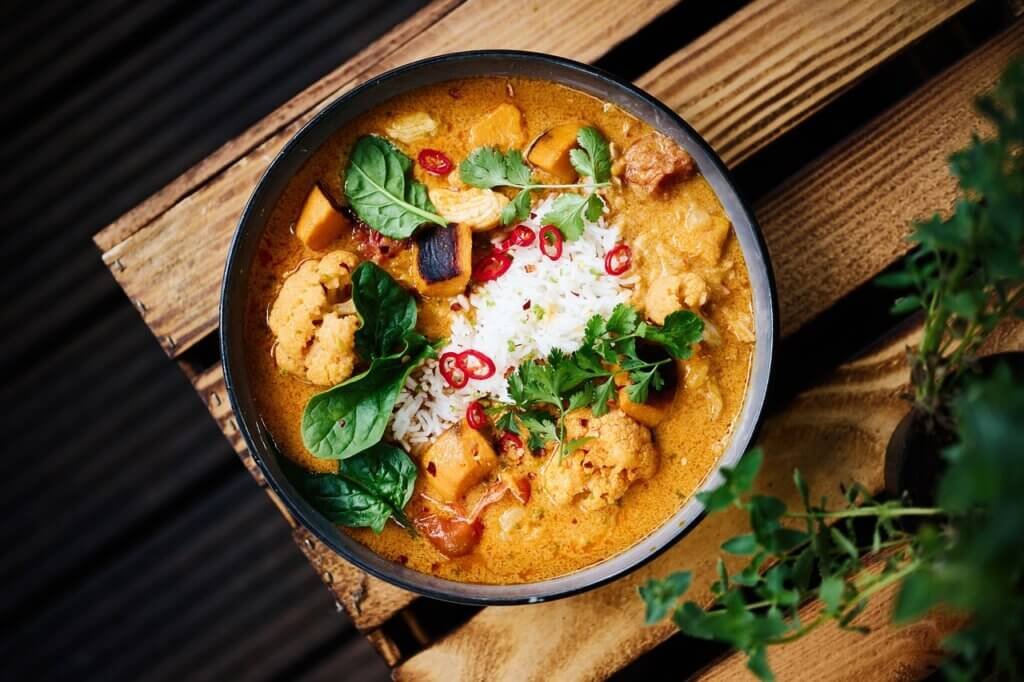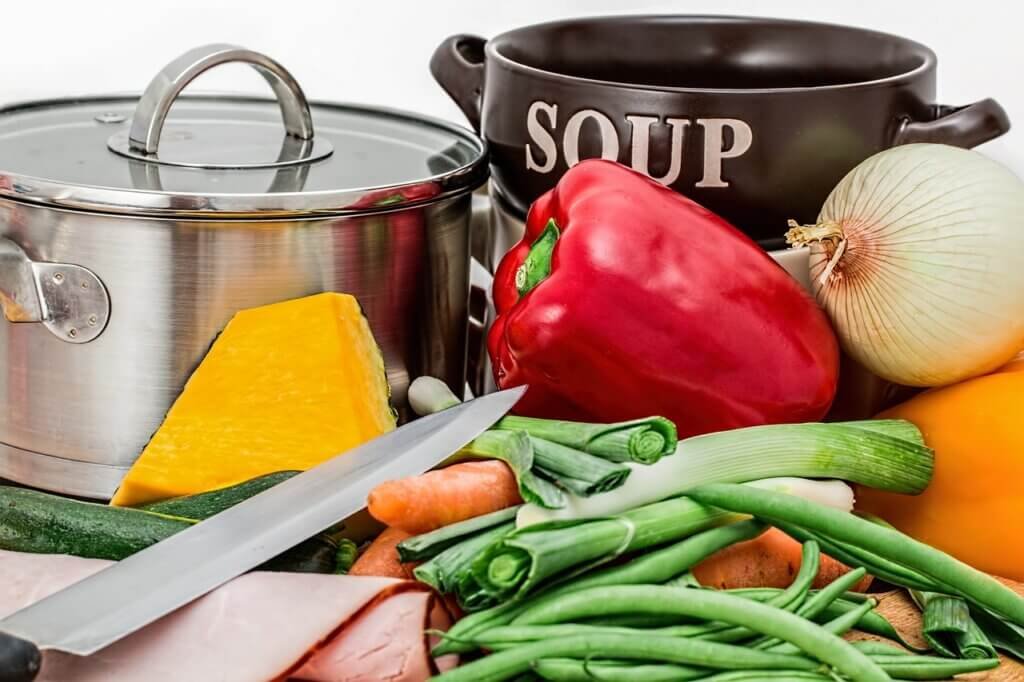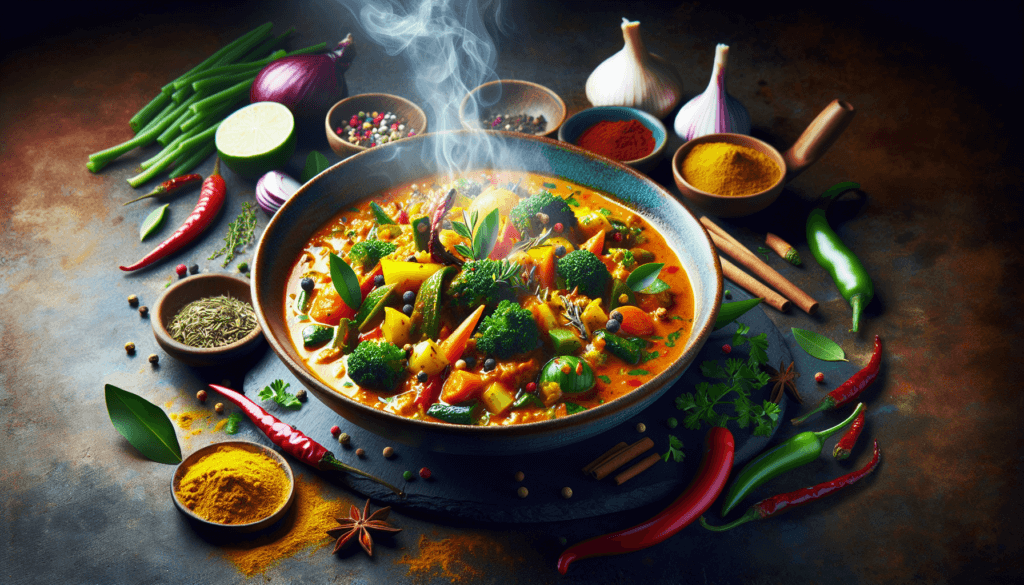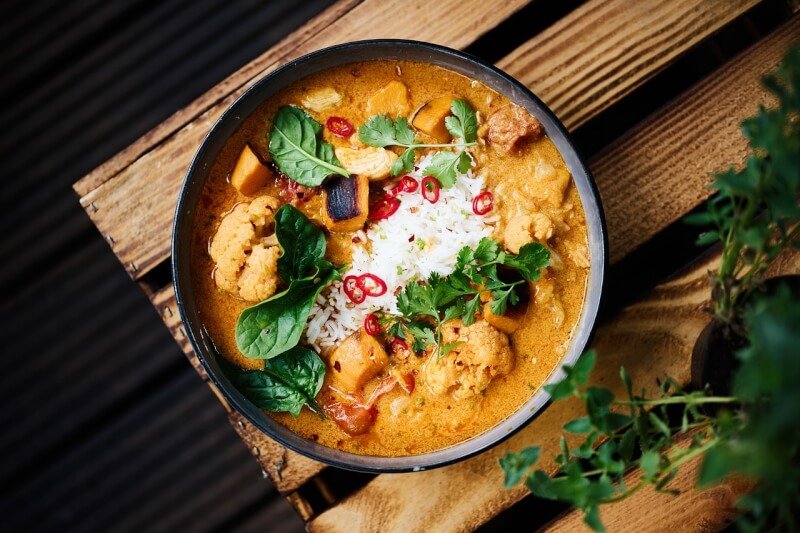Imagine stepping into your kitchen, the tantalizing aroma of spices filling the air. You can almost taste the rich flavors of a perfectly balanced curry dish as you embark on a culinary adventure. In this article, we will guide you through the process of creating a flavorful and aromatic curry that will leave your taste buds dancing with delight. From selecting the right spices to mastering the art of layering flavors, we will empower you with the skills to create a curry dish that will transport you straight to the streets of India. So grab your apron and get ready to embark on a journey of culinary bliss.

Choose the Right Spices
When it comes to cooking a flavorful and aromatic curry dish, choosing the right spices is crucial. Spices are the heart and soul of any curry, and they play a key role in developing complex flavors. To create a delicious curry, it’s important to understand the spice basics and experiment with different spice combinations.
Understand the Spice Basics
Before diving into the world of spices, it’s essential to have a basic understanding of the different types and their characteristics. Spices can be categorized into two groups: whole spices and ground spices. Whole spices, such as cinnamon sticks, cardamom pods, and mustard seeds, add depth of flavor when toasted or fried. Ground spices, such as turmeric, cumin, and coriander, provide the base flavors of the curry.
Experiment with Different Spice Combinations
One of the joys of cooking curry is the ability to experiment with various spice combinations. Each combination can create a unique flavor profile, so don’t be afraid to get creative! Start with traditional combinations like garam masala, a blend of cinnamon, cardamom, and cloves, or try out more adventurous combinations like a South Indian spice mix, featuring fenugreek, mustard seeds, and black pepper. Remember to adjust the amounts according to your taste preferences.
Use Fresh Spices for Maximum Flavor
To truly elevate the flavor of your curry, opt for fresh spices whenever possible. Freshly ground spices have a more vibrant aroma and flavor compared to pre-packaged, store-bought spices. Invest in a good quality spice grinder or mortar and pestle to grind your spices just before using them. This will ensure that you capture the full essence and potency of each spice, resulting in a more flavorful curry.
Prepare Fresh Ingredients
Another key aspect of creating a flavorful and aromatic curry dish is the use of fresh ingredients. Fresh vegetables, quality protein sources, and fragrant herbs and aromatics all contribute to the overall taste and aroma of the curry.
Select Fresh Vegetables
When selecting vegetables for your curry, choose those that are fresh and in season. Fresh vegetables have better texture and flavor compared to their wilted counterparts. Opt for a variety of vegetables to add depth and color to your curry. Popular choices include onions, tomatoes, bell peppers, carrots, and potatoes. Don’t forget to wash and chop them just before cooking to ensure the best taste and texture.
Choose Quality Protein Sources
For a well-rounded curry dish, including quality protein sources is essential. Whether you prefer chicken, lamb, fish, or tofu, make sure to choose fresh and high-quality options. Fresh protein not only contributes to the overall flavor but also adds richness and depth to the curry. Remember to marinate the protein with spices and aromatics before cooking to maximize its flavor potential.
Incorporate Fresh Herbs and Aromatics
Fresh herbs and aromatics are a vital part of any curry dish. They add layers of flavor and aroma that make the curry truly exceptional. Popular choices include garlic, ginger, cilantro, and curry leaves. For a more intense flavor, crush or finely chop these ingredients before adding them to the curry. Don’t be afraid to experiment with different combinations of herbs and aromatics to find your perfect balance.

Master the Art of Tempering
Tempering, also known as tadka, is a technique used in Indian cooking to infuse spices and aromatics into hot oil or ghee before adding them to the curry. It is a key step in creating a rich and flavorful curry dish.
Heat the Oil or Ghee
To begin the tempering process, heat oil or ghee in a pan over medium heat. The choice of oil or ghee depends on personal preference and the flavor profile you want to achieve. Traditional choices include mustard oil, ghee, or vegetable oil. Allow the oil or ghee to heat until it shimmers slightly, indicating that it’s ready for the next step.
Add Whole Spices for Depth of Flavor
Once the oil or ghee is hot, add whole spices to infuse their flavors into the fat. Common whole spices used in tempering include mustard seeds, cumin seeds, and curry leaves. These spices release a burst of flavor when heated, lending depth and complexity to the curry. Allow the spices to sizzle and pop for a few seconds to release their full aroma.
Fry Chopped Onions until Golden Brown
After adding the whole spices, it’s time to add chopped onions to the pan. Fry the onions until they turn golden brown and develop a sweet and caramelized flavor. Stir occasionally to prevent burning. The golden brown onions will add richness and sweetness to the curry, enhancing the overall taste and texture.
Create a Flavorful Curry Paste
A well-prepared curry paste is the backbone of a flavorful and aromatic curry dish. It’s a concentrated blend of spices, aromatics, and other ingredients that forms the base of the curry.
Choose the Base Ingredients for the Paste
To create a flavorful curry paste, start by selecting the base ingredients. Common choices include onions, garlic, ginger, and tomatoes. These ingredients provide a foundation of flavor upon which the other spices and aromatics can build. Chop or grate them finely to ensure they blend well into a smooth paste.
Mix in the Spices and Aromatics
Once you have the base ingredients ready, it’s time to incorporate the spices and aromatics. This is where you can get creative and experiment with different combinations to achieve the desired flavor. Common spices include turmeric, cumin, coriander, and chili powder. Aromatics like cinnamon, cloves, cardamom, and bay leaves can also be added for extra depth and complexity.
Blend or Grind into a Smooth Paste
After combining all the ingredients, blend or grind them into a smooth paste. You can use a blender, food processor, or mortar and pestle depending on your preference and the desired texture of the paste. Take your time to ensure that all the ingredients are evenly incorporated, resulting in a flavorful and aromatic curry paste.

Enhance the Flavor with Seasonings
To truly elevate the flavor of your curry, it’s important to incorporate seasonings that balance and enhance the overall taste profile. Seasonings like salt, sugar or jaggery, and tanginess from tamarind or lime juice can add depth and complexity to the curry.
Balance the Spice with Salt
Salt is a crucial seasoning that helps to balance the flavors in your curry. It enhances the natural flavors of the ingredients and rounds out the overall taste profile. Add salt gradually and taste as you go to ensure that you don’t overpower the curry. Remember, you can always add more salt later if needed, but it’s difficult to remove excess salt once it’s been added.
Add Sweetness with Sugar or Jaggery
Depending on the spice level and flavor profile of your curry, you may want to add a touch of sweetness to balance the heat and acidity. Sugar or jaggery is commonly used to add a subtle sweetness to the curry. Start with a small amount, taste, and adjust as needed. The sweetness should complement the other flavors without overpowering them.
Include Tanginess with Tamarind or Lime Juice
Tanginess is another important element in a well-rounded curry dish. It helps to brighten the flavors and adds a refreshing note to the overall taste profile. Tamarind paste or lime juice are commonly used to achieve this tangy sensation. Start with a small amount, taste, and adjust as needed to achieve the desired level of tanginess in your curry.
Control the Heat Levels
The level of heat in a curry can make or break the dish. It’s important to control the heat levels to ensure that the curry is enjoyable for everyone. Adjusting the amount of chilies used, removing or retaining the seeds and membranes, and introducing heat gradually in the cooking process are all effective ways to control the heat levels.
Adjust the Amount of Chilies Used
Chilies are the primary source of heat in most curry dishes. Depending on your preference and tolerance for heat, you can adjust the amount of chilies used. If you prefer a milder curry, reduce the number of chilies or opt for milder varieties. On the other hand, if you enjoy a spicier curry, increase the number of chilies or use hotter varieties.
Remove or Retain the Seeds and Membranes
The heat of chilies is primarily concentrated in their seeds and membranes. If you want to reduce the heat level but still retain the flavor, remove the seeds and membranes before using the chilies in your curry. Alternatively, if you prefer a spicier curry, retain the seeds and membranes to amp up the heat.
Introduce Heat Gradually in the Cooking Process
To control the heat levels effectively, it’s best to introduce heat gradually in the cooking process. This allows the flavors to develop and for you to gauge the desired level of heat. Start with milder heat sources like whole spices or mild chili powders, and increase the heat gradually by adding hotter spices or chilies as needed. This way, you have better control over the final heat level of your curry.

Choose the Right Cooking Method
The cooking method you choose can greatly impact the flavors, textures, and overall taste of your curry dish. Whether you simmer, slow cook, or pressure cook, each method offers distinct advantages and produces different results.
Simmer to Develop Flavors
Simmering is a common cooking method for curries, especially when using tender cuts of meat or delicate vegetables. Simmering allows the flavors to meld together, resulting in a cohesive and well-rounded dish. It also helps to develop richness and depth as the curry slowly cooks over low heat. This method is ideal for curries that require a shorter cooking time.
Slow Cook for a Rich and Deep Curry
Slow cooking is perfect for curries that benefit from long, slow simmering. This method allows the flavors to intensify and meld together over an extended period. Tough cuts of meat, such as beef or lamb, can be transformed into tender and flavorful morsels through slow cooking. The low and slow heat helps to break down the connective tissues, resulting in a rich and deep curry.
Try Pressure Cooking for Efficiency
If you’re short on time but still want to enjoy a flavorful curry, pressure cooking can be a great option. Pressure cooking helps to lock in the flavors and cook the ingredients quickly. This method is particularly useful for curries that have a longer cooking time, as it reduces the cooking time significantly. While the flavors may not develop as deeply compared to slow cooking, pressure cooking still delivers a delicious curry in a fraction of the time.
Fine-tune the Consistency and Texture
The consistency and texture of a curry greatly impact the overall dining experience. Whether you prefer a thick and creamy curry or a lighter and more liquid consistency, there are various ways to fine-tune the texture to suit your preferences.
Thicken with Cream, Coconut Milk, or Yogurt
To achieve a creamy and luscious curry, consider adding cream, coconut milk, or yogurt to thicken the sauce. These ingredients not only impart a rich texture but also add a subtle sweetness and tanginess to the curry. Add them towards the end of the cooking process, allowing them to meld with the other flavors while retaining their creaminess.
Use Vegetable Purees for Creamy Texture
For a vegetarian or vegan curry, vegetable purees can be used to achieve a creamy texture without dairy products. Purees made from ingredients like cauliflower, pumpkin, or cashew nuts can add a velvety smoothness to the curry. Simply blend or cook these vegetables until soft, then puree them and add them to the curry for a creamy and satisfying texture.
Reduce or Thin the Curry as Desired
The thickness of a curry is a matter of personal preference. If you find your curry to be too thick, you can gradually add small amounts of water, broth, or coconut milk to thin it out. On the other hand, if your curry is too thin, you can simmer it uncovered for a longer period to reduce the liquid and achieve a thicker consistency. Adjust the consistency as desired to ensure a satisfying dining experience.

Finish with a Flavorful Tadka or Tempering
A well-executed tadka, also known as tempering, can add a final burst of flavor and aroma to your curry. It’s a technique where hot ghee or oil is infused with spices and aromatics, then poured over the curry just before serving.
Heat Ghee or Oil for Tadka
To begin the tadka, heat ghee or oil in a small pan over medium heat. Ghee is traditionally used for its rich and nutty flavor, but you can use oil if preferred. Let the ghee or oil heat until it shimmers slightly, indicating that it’s hot enough for tempering.
Add Spices and Aromatics for Infusion
Once the ghee or oil is hot, add spices and aromatics to infuse their flavors. Common choices include mustard seeds, cumin seeds, dried red chilies, and curry leaves. The spices will sizzle and release their aromatic oils as they are tempered in the hot ghee or oil. This infuses the final burst of flavor into the tadka.
Pour the Tadka over the Curry
After the spices and aromatics have tempered, carefully pour the hot tadka over the curry just before serving. The sizzling hot ghee or oil will spread the flavors and aromas throughout the curry, enhancing the overall taste profile. The tadka is the final touch that elevates the flavors and adds a tantalizing aroma, making your curry dish truly irresistible.
Garnish and Serve with Complementary Ingredients
To complete your flavorful and aromatic curry dish, don’t forget to garnish and serve it with complementary ingredients. These additions add freshness, texture, and extra flavors to the curry, enhancing the overall dining experience.
Add Fresh Herbs and Greens as Garnish
Garnishing your curry with fresh herbs and greens adds a burst of freshness and color. Chopped cilantro, mint leaves, or green onions can be sprinkled over the curry just before serving. These vibrant garnishes not only add visual appeal but also contribute their own unique flavors, taking your curry to the next level.
Serve with Fragrant Basmati Rice or Naan
Aromatic rice, such as basmati, or freshly made naan bread make the perfect accompaniments to your curry. The fragrant rice adds a lovely aroma while the naan provides a soft and chewy texture. The combination of curry with rice or naan creates a satisfying and complete meal that is sure to please.
Accompany with Yogurt, Pickles, or Chutney
To further enhance the flavors of your curry, serve it with a side of yogurt, pickles, or chutney. Yogurt provides a cool and creamy contrast to the spices, while pickles or chutney add a tangy and spicy element. These condiments complement the curry and offer a variety of flavors to explore with each bite.
By following these tips and techniques, you can create a flavorful and aromatic curry dish that will impress your family and friends. From choosing the right spices to adding the perfect garnishes, each step plays a role in creating a memorable culinary experience. So, put on your apron, gather your ingredients, and get ready to embark on a journey of culinary delight with your very own homemade curry.


